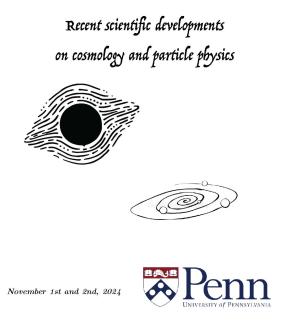News

2025 Sloan Research Fellows
The University of Pennsylvania’s Jason Altschuler, César de la Fuente, Liang Wu, and Anderson Ye Zhang have each been selected to receive a 2025 Sloan Research Fellowship, which recognizes early-career scientists in North America.

Department Scholar in Residence Update: Sculpture Installation on Cover of Arts Based Research Book
Portal, a sculpture installation inspired by research of black holes created by Rebecca Kamen, visiting scholar and artist in residence in the Department of Physics and Astronomy, has been selected as the cover image for the second edition of Handbook of Arts-Based Research. Published by Guilford Press, the book also includes a chapter on the research and development of Kamen’s art/science work.

The Missing Data Link
When Bhuvnesh Jain and Greg Ridgeway co-founded the Data Driven Discovery Initiative (DDDI) in 2021, their initial goal was to support the undergraduates, graduate students, and postdocs across the School of Arts & Sciences (SAS) who were applying data science tools in their studies and research.

A less ‘clumpy,’ more complex universe?
Researchers combined cosmological data from two major surveys of the universe’s evolutionary history and found that it may have become ‘messier and complicated’ than expected in recent years.

The White House Honors Nearly 400 Federally Funded Early-Career Scientists
The PECASE (Presidential Early Career Award for Scientists and Engineers) honorary award winners from 2018-22 were officially announced by the White House today. Congratulations to Bo Zhen, who was one of the winners through the Army Research Office!

Fruit flies and physics
Penn Physicist Andrea Liu and collaborators modeled the behavior of tissue during a stage of fly development and found, surprisingly, it doesn’t fluidize as it shrinks but stays solid. Their approach could offer insights physical systems with complex functionality.

Presidential Early Career Award for Scientists and Engineers by the Army Research Office Selection
Liang Wu has been selected for the Presidential Early Career Award for Scientists and Engineers by the Army Research Office. The award recognizes Liang's overall achievements and his proposed research on “Topological Nonlinear Optics”. The PECASE is a truly high honor that, among other things, is typically accompanied by a trip to the White House!

Bo Zhen Named Jin K. Lee Presidential Associate Professor of Physics and Astronomy
Bo Zhen, Associate Professor of Physics and Astronomy, has been named Jin K. Lee Presidential Associate Professor of Physics and Astronomy. Zhen’s research focuses on the study of electromagnetic waves, such as light, in engineered environment. His group investigates exotic phenomena in condensed matter physics and quantum electrodynamics while pursuing practical applications in areas like infrared light detection, quantum control and readout, and quantum sensing.

Recent Scientific Developments on Cosmology and Particle Physics
A collaborative workshop bringing together participants from nearby universities to advance research in cosmology and particle physics.

Space-Time: The Biggest Problem in Physics
As part of a series that seeks to unpack fundamental mysteries in theoretical physics, Quanta Magazine met with Vijay Balasubramanian of the School of Arts & Sciences to discuss science’s biggest problem: space-time. Balasubramanian says that at the smallest conceivable scales, “the laws of nature break down. The stage of our universe, space-time, seems to dissolve, and we can’t make sense of the awful chaos underneath.
